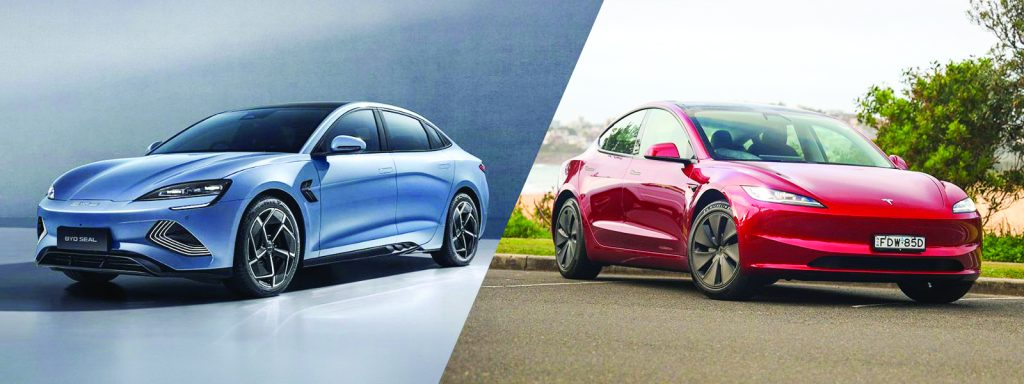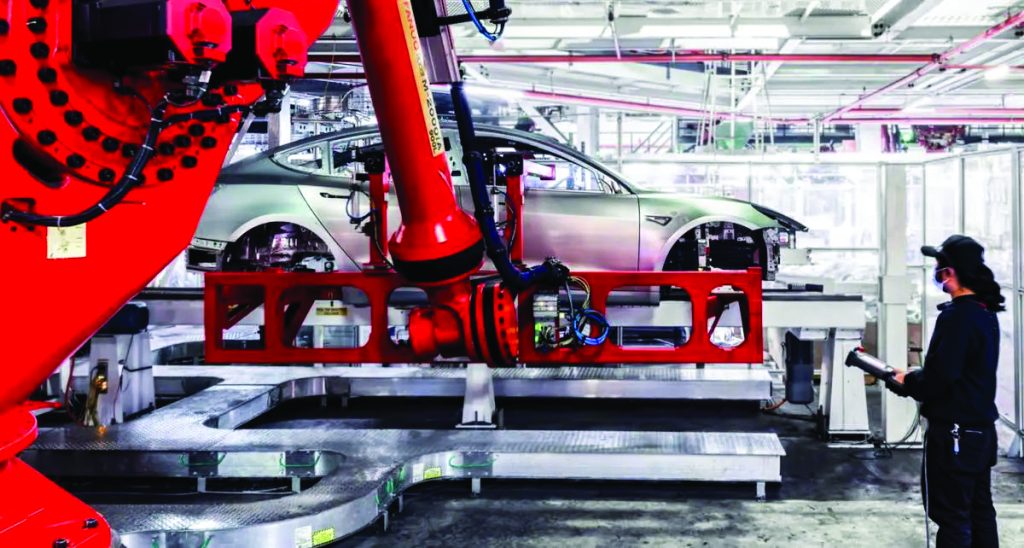Words: Jonathan Westbrook.

BYD model and Tesla model 3.
Global Market Overview
The electric vehicle (EV) market has seen impressive growth over the past few years, with numerous automakers establishing themselves as key players. Two of the most prominent companies in the global EV market are Tesla and BYD (Build Your Dreams), both of which have consistently vied for the top spot in terms of global sales and market share. Other key players include Volkswagen, NIO, Xpeng, General Motors, and Hyundai, but Tesla and BYD dominate the landscape.
Market Share Breakdown (as of 2023)
1. BYD: 18 percent global market share
2. Tesla: 15 percent global market share
3. Volkswagen Group: seven percent global market share
4. General Motors (GM): five percent global market share
5. Hyundai-Kia Group: four percent global market share
6. SAIC Motor: four percent global market share
7. NIO and Xpeng: three percent (combined) global market share
BYD vs. Tesla: A Comparative Analysis
Sales Volume and Market Share
BYD has recently surpassed Tesla in terms of overall EV sales, securing approximately 18 percent of the global market share by the end of 2023. BYD’s success is largely due to its dominance in China, the world’s largest EV market, and its growing international presence.
Tesla, once the undisputed leader of the EV market, holds about 15 percent of the global market share. Tesla still leads in key markets like the United States and Europe, but its dominance is being challenged by BYD and other automakers, especially in China.
Geographical Dominance
BYD has a strong foothold in China, which accounts for 60 percent of the global EV market. It dominates in terms of both Battery Electric Vehicles (BEVs) and Plug-in Hybrid Electric Vehicles (PHEVs). In 2023, China represented the bulk of BYD’s sales, with more than 80 percent of its vehicles sold domestically. However, BYD has been expanding aggressively into global markets, including Europe and Latin America.
Tesla, on the other hand, continues to be a global powerhouse, with the United States as its largest market, where it holds more than 60 percent of the EV market share. Tesla also has a strong presence in Europe, particularly in countries like Germany, the UK, and Norway, which are key EV markets. Tesla’s Shanghai Gigafactory has also allowed it to secure a significant presence in China, though it lags behind BYD in overall sales there.
Product Range and Segmentation
BYD offers a wide range of vehicles across different price points. It produces not only BEVs but also PHEVs, giving it a broader appeal to consumers who are not ready to fully transition to electric. BYD’s offerings span from affordable models like the BYD Dolphin and BYD Yuan Plus to premium vehicles such as the BYD Han and the luxury Yangwang U8. This diversity in its lineup has allowed BYD to attract a broader audience.
Tesla, in contrast, focuses exclusively on Battery Electric Vehicles (BEVs). Tesla has a more streamlined model range, consisting of premium vehicles such as the Model 3, Model S, Model X, and the Model Y. Tesla’s strategy has been to focus on the high-end and mid-range market, though its introduction of more affordable models like the Model 3 has helped it reach a wider consumer base.
Technology and Innovation
Tesla is widely regarded as a technological leader in the EV industry. Tesla’s vehicles are known for their advanced battery technology, autonomous driving capabilities, and over-the-air software updates, which allow Tesla to improve performance and add features even after the cars are sold. Tesla’s Supercharger network, which offers fast-charging capabilities, is also a significant competitive advantage.
BYD has been making strides in battery technology as well, particularly with its proprietary Blade Battery, which offers improved safety and energy density. BYD has also invested heavily in expanding its EV charging infrastructure and in developing autonomous driving technologies. While BYD may not have the same global reputation for cutting-edge tech as Tesla, its vertically integrated approach (producing its own batteries and components) has given it a significant edge in managing production costs and supply chain stability.
Manufacturing Capacity and Expansion
BYD benefits from its scale and vertical integration, manufacturing not just vehicles but also many of the key components, including batteries. This allows BYD to manage costs more effectively than many of its competitors. The company is expanding its manufacturing capacity with new factories outside China, targeting markets in Europe, Latin America, and Southeast Asia.
Tesla has a global manufacturing footprint, with Gigafactories in the United States, China, and Germany. Tesla has ambitious plans to continue expanding its global footprint, with plans to increase production at existing facilities and open new ones in emerging markets. Tesla’s manufacturing efficiency, particularly its use of Giga Presses and other advanced techniques, has helped reduce production costs while maintaining high profit margins.
Challenges and Future Prospects
BYD: BYD’s greatest challenge is scaling up outside of China, where it faces stiff competition from Tesla and European automakers. The company is relatively new to many international markets and will need to build brand recognition and customer trust. However, its cost-effective vehicles and diversified product range give it a strong competitive position in emerging markets.
Tesla: Tesla continues to face challenges, particularly in China, where competition from domestic brands like BYD is fierce. Additionally, Tesla’s reliance on the U.S. and Europe for a significant portion of its sales could expose it to risks associated with regional market conditions. However, Tesla’s strong brand and reputation for innovation provide it with a solid foundation to remain a key player in the global EV market.
Conclusion: BYD vs. Tesla
While BYD has surpassed Tesla in terms of overall sales and market share, particularly due to its dominance in China, Tesla remains a powerful global force in the EV industry, especially in premium markets and in regions like the U.S. and Europe. BYD’s strength lies in its diversified product range and vertical integration, which allow it to compete across various market segments, while Tesla’s advantages are rooted in its cutting-edge technology and brand strength.
In the future, the competition between BYD and Tesla is expected to intensify, especially as both companies continue to expand globally and innovate in the areas of battery technology, autonomous driving, and manufacturing efficiency. Ultimately, both BYD and Tesla are likely to remain leaders in the electric vehicle market, each shaping the industry in its own way.

EV dashboard reflects the advanced technology and digital interfaces that set these vehicles apart from traditional cars.

At the Tesla manufacturing premises.





